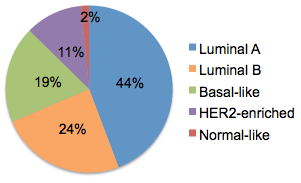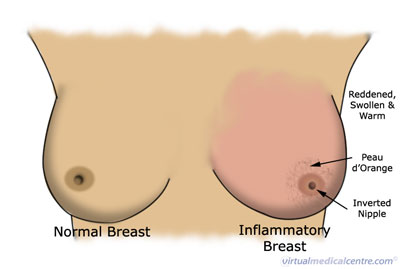New imaging technique can identify breast cancer subtypes and early treatment response
An optical imaging technique that measures metabolic activity in cancer cells can accurately differentiate breast cancer subtypes, and it can detect responses to treatment as early as two days after therapy administration, according to a study published in Cancer Research, a journal of the American Association for Cancer Research.
“The process of targeted drug development requires assays that measure drug target engagement and predict the response (or lack thereof) to treatment,” said Alex Walsh, a graduate student in the Department of Biomedical Engineering at Vanderbilt University in Nashville, Tenn. “We have shown that optical metabolic imaging (OMI) enables fast, sensitive, and accurate measurement of drug action. Importantly, OMI measurements can be made repeatedly over time in a live animal, which significantly reduces the cost of these preclinical studies.”
Human cells undergo extensive chemical reactions called metabolic activity to produce energy, and this activity is altered in cancer cells. When cancer cells are treated with anticancer drugs, their metabolic activity changes. OMI takes advantage of the fact that two molecules involved in cellular metabolism, called nicotinamide adenine dinucleotide (NADH) and flavin adenine dinucleotide (FAD), naturally emit fluorescence when exposed to certain forms of light. In this way, OMI generates distinct signatures for cancer cells with a different metabolism and their responses to drugs.
Walsh and colleagues used a custom-built, multiphoton microscope and coupled it with a titanium-sapphire laser that causes NADH and FAD to emit fluorescence. They used specific filters to isolate the fluorescence emitted by these two molecules, and measured the ratio of the two as “redox ratio.”
When they placed normal and cancerous breast cells under the microscope, OMI generated distinct signals for the two types of cells. OMI could also differentiate between estrogen receptor-positive, estrogen receptor-negative, HER2-positive, and HER2-negative breast cancer cells.
Next, the researchers tested the effect of the anti-HER2 antibody trastuzumab on three breast cancer cell lines that respond differently to the antibody. They found that the redox ratios were significantly reduced in drug-sensitive cells after trastuzumab treatment but unaffected in the resistant cells.
 They then grew human breast tumors in mice and treated some of these with trastuzumab. When they imaged tumors in live mice, OMI showed a difference in response between trastuzumab-sensitive and -resistant tumors as early as two days after the first dose of the antibody. In comparison, FDG-PET imaging, the standard clinical metabolic imaging technique, could not measure any difference in response between trastuzumab-sensitive and -resistant tumors at any time point in the experiment, which lasted 12 days.
They then grew human breast tumors in mice and treated some of these with trastuzumab. When they imaged tumors in live mice, OMI showed a difference in response between trastuzumab-sensitive and -resistant tumors as early as two days after the first dose of the antibody. In comparison, FDG-PET imaging, the standard clinical metabolic imaging technique, could not measure any difference in response between trastuzumab-sensitive and -resistant tumors at any time point in the experiment, which lasted 12 days.
“Cancer drugs have profound effects on cellular energy production, and this can be harnessed by OMI to identify responding cells from nonresponding cells,” said Walsh. “We are hoping to develop a high-throughput screening method to predict the optimal drug treatment for a particular patient.”
 Importantly, OMI can be used on tissues freshly excised from patients but, with further development, it could be incorporated in endoscopes for live imaging of human cancers, according to the investigators.
Importantly, OMI can be used on tissues freshly excised from patients but, with further development, it could be incorporated in endoscopes for live imaging of human cancers, according to the investigators.
###
This study was funded by the National Institutes of Health, the National Science Foundation, the Department of Defense Breast Cancer Research Program, Vanderbilt-Ingram Cancer Center, and Vanderbilt University Medical Center. The authors have no conflicts of interest to disclose.
About the American Association for Cancer Research
Founded in 1907, the American Association for Cancer Research (AACR) is the world’s oldest and largest professional organization dedicated to advancing cancer research and its mission to prevent and cure cancer. AACR membership includes more than 34,000 laboratory, translational, and clinical researchers; population scientists; other health care professionals; and cancer advocates residing in more than 90 countries. The AACR marshals the full spectrum of expertise of the cancer community to accelerate progress in the prevention, biology, diagnosis, and treatment of cancer by annually convening more than 20 conferences and educational workshops, the largest of which is the AACR Annual Meeting with more than 18,000 attendees. In addition, the AACR publishes eight peer-reviewed scientific journals and a magazine for cancer survivors, patients, and their caregivers. The AACR funds meritorious research directly as well as in cooperation with numerous cancer organizations. As the scientific partner of Stand Up To Cancer, the AACR provides expert peer review, grants administration, and scientific oversight of team science and individual grants in cancer research that have the potential for near-term patient benefit. The AACR actively communicates with legislators and policymakers about the value of cancer research and related biomedical science in saving lives from cancer.
To interview Alex Walsh, contact Dagny McMillin at 615-936-7245 or dagny.stuart@vanderbilt.edu. For other inquiries, contact Jeremy Moore at jeremy.moore@aacr.org or 215-446-7109.
###
Jeremy Moore
jeremy.moore@aacr.org
215-446-7109
American Association for Cancer Research